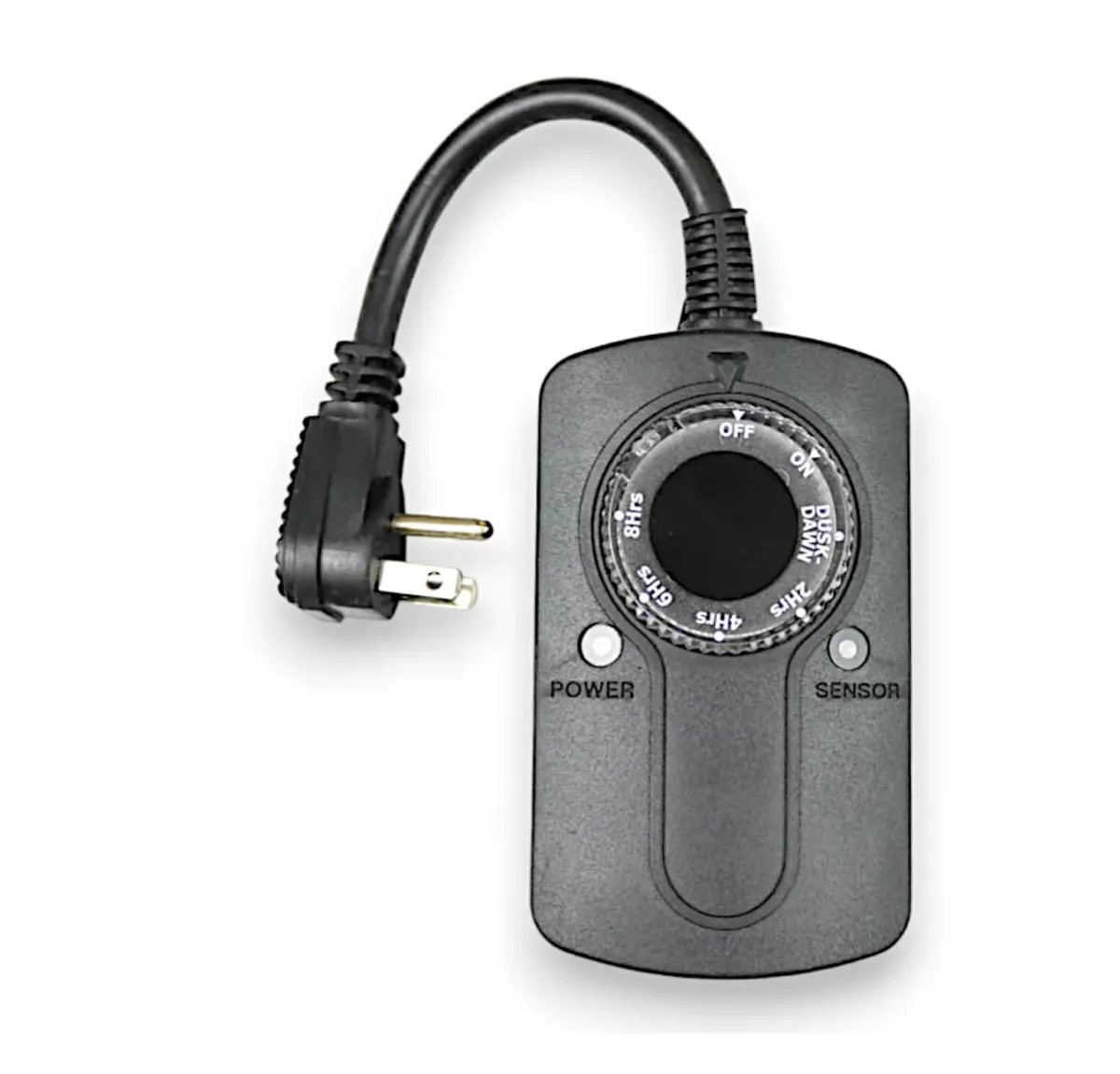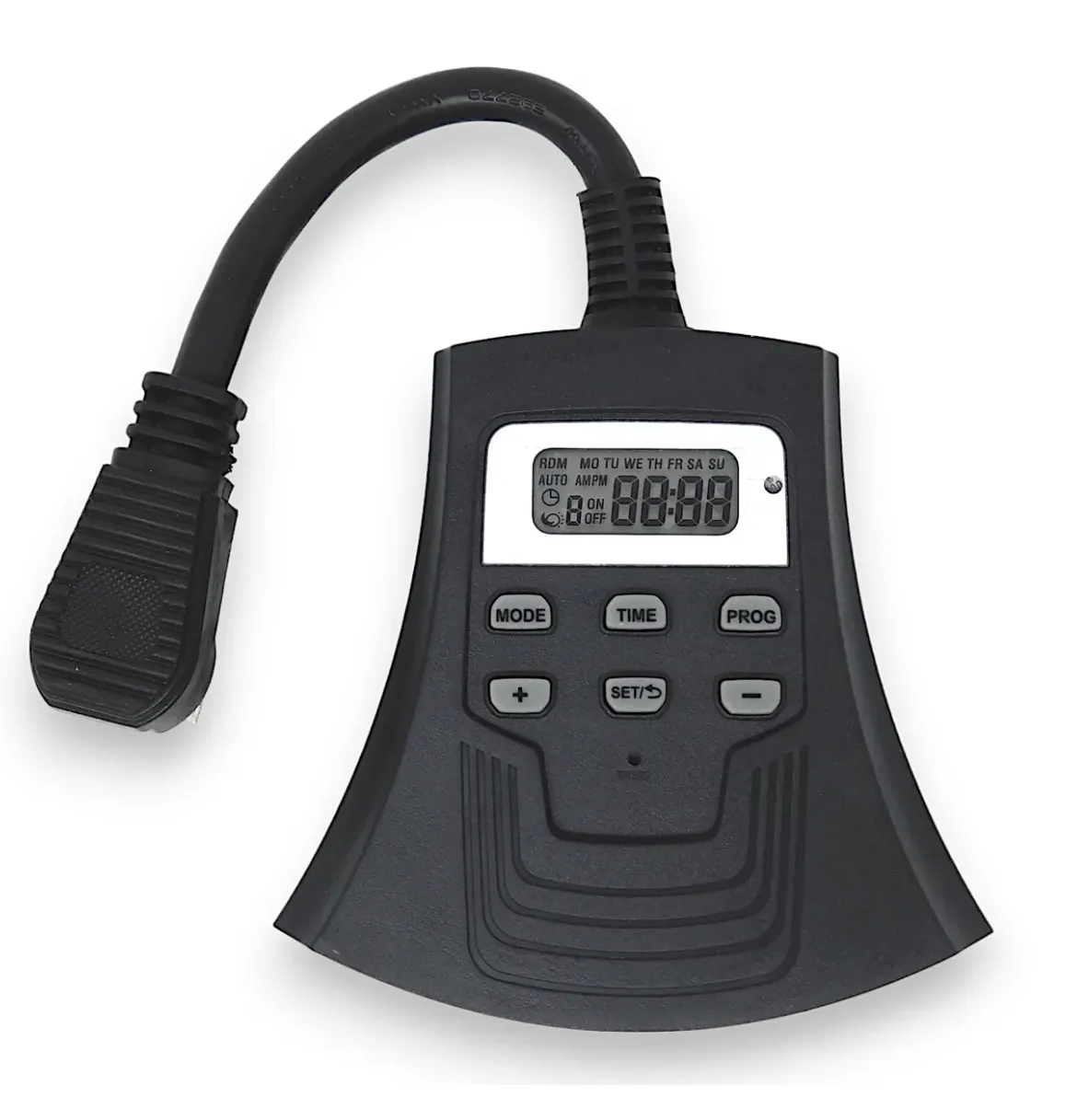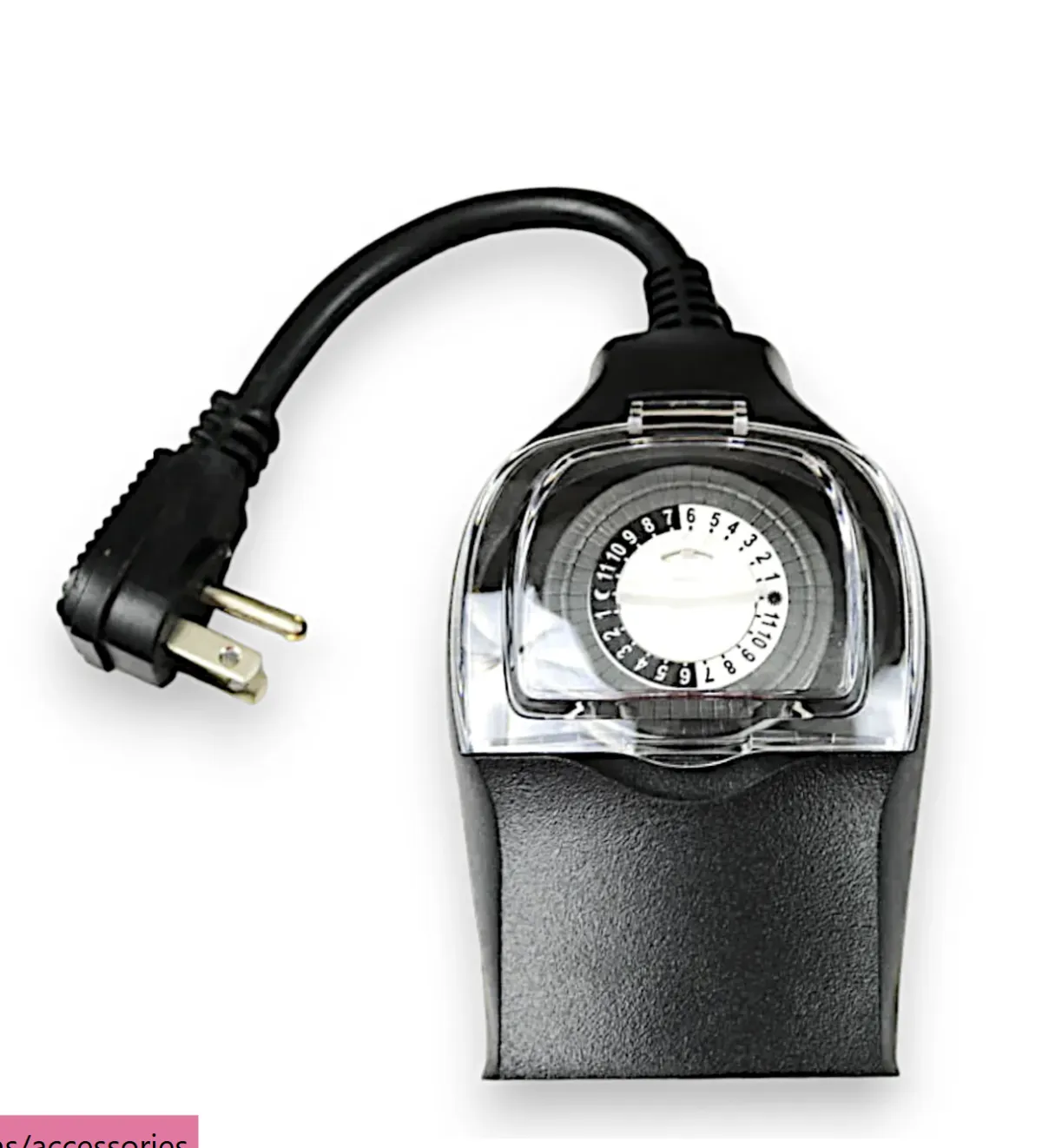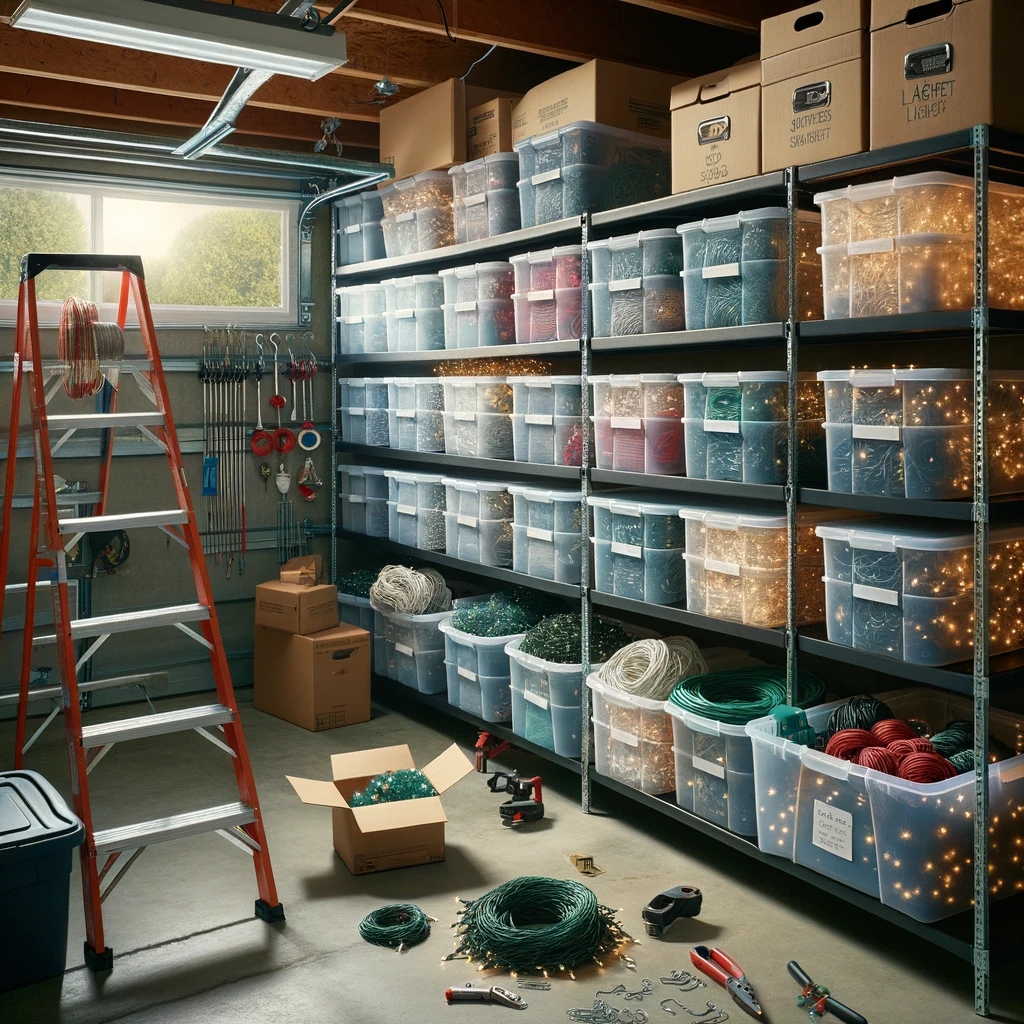Precision Control for Your Holiday Illuminations: Professional-Grade Outdoor Timers
Elevate your holiday lighting displays with our collection of professional-grade outdoor timers. These essential tools offer precise control and energy efficiency for your festive illuminations. Whether you're a professional installer or a homeowner looking to enhance your holiday decor, our range of timers provides the perfect solution for managing your lights with ease. From photo cell timers that automatically adjust to daylight changes, to digital and mechanical options offering customizable schedules, our selection ensures your displays shine at just the right times. Designed for both indoor and outdoor use, these durable timers combine convenience with reliability, helping you create magical holiday atmospheres while conserving energy. Discover how our timers can transform your lighting management and take your seasonal displays to the next level.
Timers
Photo Cell Timer
Enhance your holiday lighting control with our versatile Photo Cell Timer featuring a convenient right-angle plug. This intelligent device offers two outlets, providing flexible options for managing multiple light strings or decorations. The timer comes with a range of settings to suit your specific needs: choose between Off, On, Dusk to Dawn, or preset durations of 2, 4, 6, or 8 hours. The photo cell technology automatically detects ambient light levels, ensuring your lights turn on as darkness falls and off when daylight returns, perfect for the "Dusk to Dawn" setting. The right-angle plug design helps maximize space usage and reduces strain on your outlets. Whether you're looking to conserve energy, enhance security, or simply enjoy the convenience of automated lighting, this Photo Cell Timer is an essential tool for effortless and efficient holiday light management.
15 AMP Digital Timer
Streamline your outdoor lighting control with our efficient Mechanical Light Timer Switch Outlet. This versatile device is perfect for managing lamps, fans, garden lights, porch illumination, or holiday and Christmas displays, helping you reduce energy waste and extend the life of your decorations. The timer features customizable daily settings that you can adjust at any time, offering flexibility to match your changing needs or schedules. Built for durability, this wall-mounted timer comes with a three-prong, weatherproof design, ensuring reliable performance in various outdoor conditions. The three-switch outlet provides multiple connection options, allowing you to control several devices simultaneously. Whether you're looking to enhance security, create ambiance, or simply automate your outdoor lighting, this mechanical timer offers a user-friendly solution for effortless light management throughout the year.
Mechanical Timer
Enhance your lighting control with our versatile In/Outdoor Mechanical Timer featuring a space-saving right-angle plug. This robust device offers two outlets, allowing you to manage multiple light strings or decorations simultaneously. Designed for both indoor and outdoor use, it's perfect for holiday displays, security lighting, or everyday household needs. The 24-hour programmable cycle provides ultimate flexibility, enabling you to set precise on/off times that repeat daily. With a powerful 15-amp capacity, this timer can handle most residential lighting and small appliance loads with ease. The mechanical design ensures reliability and ease of use, with no complicated programming required. Whether you're looking to automate your Christmas lights, control patio illumination, or simply manage energy consumption, this durable and practical timer is an essential tool for efficient light management in any setting.
Frequently Asked Questions
What types of timers do you offer?
We offer a variety of timers including Photo Cell Timers with right-angle plugs, 15 AMP Digital Timers, and Mechanical Timers. Each type has unique features to suit different needs and preferences.
Are these timers suitable for outdoor use?
Yes, all of our timers are designed for both indoor and outdoor use. They are built with weatherproof features to ensure reliable performance in various outdoor conditions.
How many outlets do these timers have?
Most of our timers, including the Photo Cell Timer and the Mechanical Timer, offer two outlets. This allows you to control multiple light strings or decorations simultaneously.
What's the benefit of a Photo Cell Timer?
A Photo Cell Timer automatically detects ambient light levels, turning your lights on at dusk and off at dawn. This "Dusk to Dawn" feature provides convenient, energy-efficient operation without manual adjustments.
Can I set specific on/off times with these timers?
Yes, our timers offer programmable cycles. For instance, the Mechanical Timer has a 24-hour programmable cycle, allowing you to set precise on/off times that repeat daily. The Photo Cell Timer also offers preset durations of 2, 4, 6, or 8 hours in addition to its Dusk to Dawn setting.
Discover Expert Tips on Our Blog

Christmas Light Installer Scaling Secrets: From Solo to $500K+
The Christmas lights installation industry offers incredible opportunities for entrepreneurs looking to build a profitable seasonal business. With the right systems, strategies, and mindset, it's possible to grow from a solo operation to a multi-crew enterprise generating six or seven figures annually. This comprehensive guide will walk you through the essential steps to scale your Christmas lights business effectively.
Understanding the Growth Potential
Revenue Milestones and What They Require
The Christmas lights business has clearly defined growth stages that correlate with operational complexity. A solo operator with one helper can realistically achieve $100,000 to $250,000 in annual revenue. However, reaching the next level requires systematic changes to how the business operates.
The transition from $250,000 to $500,000 and beyond demands a fundamental shift from working in the business to working on the business. This transformation involves implementing robust systems, hiring reliable crews, and developing scalable marketing strategies that generate consistent leads.
The Foundation of Scalable Success
Building a scalable Christmas lights business starts with understanding that growth isn't just about installing more lights—it's about creating systems that allow others to install lights to your standards while you focus on business development, sales, and strategic planning.
Building Your Crew: Finding and Training Reliable Installers
The Challenge of Finding Quality Workers
One of the biggest obstacles to scaling any service business is finding reliable employees who can maintain quality standards. In the Christmas lights industry, this challenge is amplified by the seasonal nature of the work and the physical demands of roof installations.
Effective Recruitment Strategies
Create Compelling Job Advertisements Your job postings should emphasize the outdoor nature of the work and the requirement to work at heights. Be upfront about the physical demands and the need to love Christmas. This helps filter applicants who might not be suited for the work.
The On-Site Interview Process Instead of traditional interviews, implement an on-the-job evaluation system. Schedule group interviews at your most challenging job site—ideally a three-story house with a steep roof pitch. This approach serves multiple purposes:
Tests candidates' comfort with heights in real conditions
Evaluates their ability to follow basic instructions
Demonstrates the actual working conditions
Quickly identifies who can handle the physical demands
Training and Safety Protocols
Safety First Approach Safety must be the cornerstone of your training program. Recent industry incidents underscore the importance of proper ladder safety, harness use, and fall protection. Implement comprehensive safety training that includes:
Proper ladder placement and angle
Harness and rope usage
Recognition of hazardous conditions
Emergency procedures
Skills Assessment During the evaluation day, test candidates on basic electrical work like attaching male and female connectors. This reveals their ability to learn technical skills and follow detailed instructions—both crucial for quality installations.
Alternative Crew Sources
Networking in Related Industries Visit gas stations and construction sites to find workers with ladder trucks and roofing experience. Roofers often have slower seasons during winter and may welcome additional income opportunities.
Seasonal Worker Recruitment Partner with seasonal workers from industries like landscaping who may need winter employment. These workers often have experience with outdoor physical labor and customer service.
Systematizing Your Operations
The Importance of Documented Processes
Creating detailed systems documentation is essential for consistent quality across multiple crews. Every aspect of the installation process should be documented clearly enough that anyone can follow the procedures.
The 26-Step Installation System
Pre-Installation Procedures
Vehicle positioning strategies (parking on the street for visibility and safety)
Equipment checklist verification
Customer communication protocols
Installation Best Practices
Proper vest loading with necessary supplies (25 males, 50 females, two pairs of cutters)
Sequential installation procedures
Quality control checkpoints
Efficiency Optimizations Detailed systems prevent time-wasting activities like multiple trips to the truck. When installers forget tools and make repeated trips, a typical installation can extend by hours rather than minutes.
Customer Service Systems
Phone Handling Protocols Develop scripts and procedures for every customer interaction:
Initial call handling
Quote delivery process
Scheduling procedures
Follow-up communications
Administrative Systems Create standardized processes for:
Transitioning from Technician to Business Owner
The Mental Shift Required
The most challenging aspect of scaling is often psychological. Many business owners struggle with the belief that no one can perform the work as well as they can. This mindset becomes the primary limiting factor in business growth.
Benefits of Getting "Off the Truck"
Increased Revenue Potential Business owners generate more value focusing on sales, marketing, and business development than performing installations. While on installations, owners cannot:
Answer phones properly
Conduct in-person sales meetings
Develop new business relationships
Work on marketing strategies
Improved Work-Life Balance Delegation allows business owners to step away from the daily grind and focus on strategic growth activities that provide better long-term returns.
Organizational Structure Planning
Creating Your Org Chart Design an organizational chart showing all positions needed for your target business size. Initially, put your name in every position, then systematically replace yourself with qualified team members.
Essential positions include:
Installation crews
Office manager/administrator
Sales representative
Operations manager
Marketing and Lead Generation Strategies
Beyond Traditional Advertising
While yard signs can generate enough leads to reach $100,000 in revenue, scaling to seven figures requires diverse marketing approaches.
Digital Marketing Fundamentals
Website Optimization Your website should include:
Clear pricing information
Service descriptions
Customer testimonials
Easy contact methods
Search Engine Optimization Focus on local SEO strategies:
Google My Business optimization
Local keyword targeting
Customer review management
Citation building across relevant directories
Commercial Market Development
Timing Your Commercial Sales Commercial clients typically budget for large expenses months in advance. Begin commercial sales efforts in summer for the upcoming Christmas season.
Target Commercial Prospects Ideal commercial clients include:
Auto dealerships
Churches
Municipal buildings
Medical offices
Retail establishments
Restaurants and hospitality businesses
LinkedIn for B2B Sales
Platform Strategy LinkedIn serves as an excellent platform for commercial sales development. Connect personally rather than through business profiles, as the platform emphasizes person-to-person networking.
Commercial vs. Residential Focus While LinkedIn can generate some high-end residential clients (doctors, lawyers, executives), its primary value lies in commercial lead generation.

Pricing and Financial Management
Strategic Pricing Approaches
Premium Pricing Strategy Position your services at the higher end of the market. Premium pricing allows for:
Better profit margins
Higher quality materials and labor
Enhanced customer service
Sustainable business growth
Deposit and Payment Systems Implement a 50% deposit requirement for all projects. Frame this as a scheduling requirement rather than a financing need. This approach:
Improves cash flow
Reduces financing requirements
Demonstrates customer commitment
Managing Seasonal Cash Flow
Working Capital Strategies The Christmas lights business can be operated with minimal upfront capital by using customer deposits to purchase materials. This approach requires:
Storage and Logistics Solutions
Equipment Storage Options
Residential Solutions
Basement storage
Garage organization
Shed or outbuilding conversion
Commercial Storage
Storage unit rental ($300-400 monthly)
Dedicated warehouse space
Trailer-based mobile storage
Inventory Management
Year-Round Storage Strategy Store lights with clips attached to streamline the following year's installations. This approach:
Reduces installation time significantly
Maintains consistent positioning
Improves crew efficiency
Advanced Business Strategies
Service Diversification
Permanent Lighting Solutions Permanent Christmas lights represent a growing market segment with higher profit margins and year-round revenue potential.
Complementary Services Consider adding related services:
Holiday decorating
Event lighting
Landscape lighting
Pressure washing (off-season revenue)
Technology Integration
Business Management Software Implement comprehensive business management tools:
Customer relationship management (CRM)
Scheduling and dispatch software
Financial management systems
Inventory tracking solutions
Quality Control and Customer Satisfaction
Maintaining Standards Across Multiple Crews
Regular Inspections Implement systematic quality control processes:
Random installation inspections
Customer feedback collection
Crew performance evaluations
Continuous training updates
Customer Communication Maintain consistent communication standards:
Installation scheduling updates
Progress notifications
Completion confirmations
Follow-up service calls
Conclusion: Building a Sustainable Christmas Lights Empire
Scaling a Christmas lights business requires a fundamental shift from artisan to entrepreneur. Success depends on developing robust systems, building reliable teams, and implementing effective marketing strategies that generate consistent commercial and residential leads.
The businesses that achieve seven-figure revenues share common characteristics: they prioritize systems over individual performance, invest in quality training and safety protocols, and maintain unwavering focus on customer satisfaction. They also recognize that growth requires stepping away from day-to-day operations to focus on strategic business development.
By following these proven strategies and maintaining commitment to excellence, Christmas lights installation businesses can achieve remarkable growth while building sustainable enterprises that provide significant value to both customers and employees. The seasonal nature of the business, combined with strong market demand, creates exceptional opportunities for entrepreneurs willing to implement professional business practices and scale systematically.
The key is remembering that every successful business started with a single installation, but grew through the disciplined application of proven business principles adapted to the unique characteristics of the Christmas lighting industry.

1. How much revenue can I realistically expect as I grow my Christmas lights business?
Answer: Revenue potential varies significantly based on your operational model. A solo operator with one helper can achieve $100,000-$250,000 annually. With two crews (one full-time, one part-time), you can reach $500,000-$600,000. To break into seven figures, you'll need multiple crews, strong commercial contracts, and systematic business operations. The key is understanding that each growth stage requires different systems and management approaches.
2. What's the best way to find reliable crew members for roof installations?
Answer: Skip traditional interviews and implement an on-site evaluation system. Schedule group interviews at your most challenging job site—ideally a three-story house with steep roof pitch. This approach quickly identifies candidates who can handle heights, follow instructions, and perform basic electrical work. Also network at gas stations and construction sites to find workers with ladder trucks and roofing experience who need winter work.
3. When should I stop doing installations myself and focus on running the business?
Answer: The sooner you transition "off the truck," the more money you'll make. Business owners generate more value through sales, marketing, and business development than performing installations. While installing, you can't answer phones properly, conduct sales meetings, or work on growth strategies. Start delegating installations as soon as you have reliable, trained crews and documented systems in place.
4. How should I handle deposits and payments to manage cash flow?
Answer: Require a 50% deposit for all projects, but frame it as a scheduling requirement rather than a financing need. Tell customers they need to put 50% down "to get on the schedule," not to buy lights. This approach improves cash flow, reduces your financing requirements, and demonstrates customer commitment while maintaining a professional image.
5. When and how should I start targeting commercial clients?
Answer: Begin commercial sales efforts in summer for the upcoming Christmas season, as businesses budget large expenses months in advance. Target auto dealerships, churches, municipal buildings, medical offices, retail establishments, and restaurants. Use LinkedIn for B2B networking, focusing on personal connections rather than business profiles. Commercial clients offer higher revenue per project and help scale your business significantly.
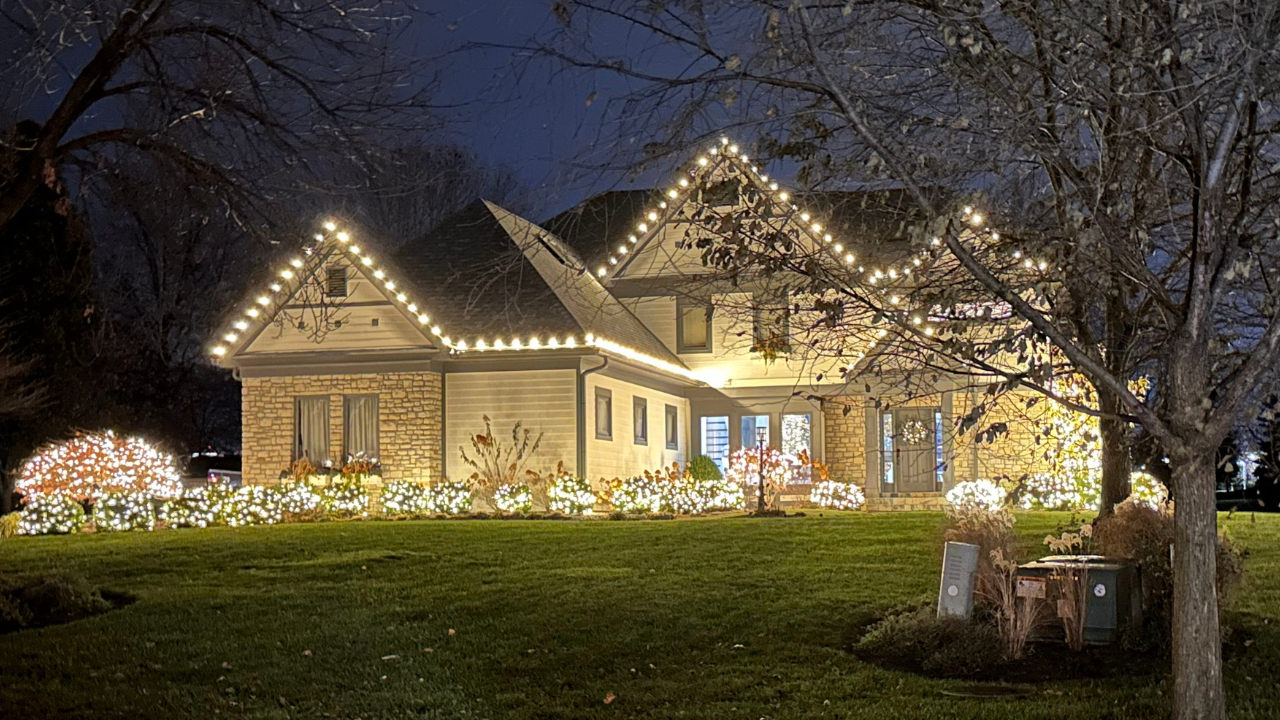
6. Where should I store my Christmas lights and equipment?
Answer: Storage options include basements, garages, storage units ($300-400/month), dedicated warehouse space, or trailers. Store lights with clips attached to streamline next year's installations—this can reduce installation time from hours to 45-75 minutes per house. Plan for significant storage needs as you scale; a half-million-dollar inventory might require a 20x30 room.
7. How do I ensure safety when working on roofs and at heights?
Answer: Safety must be your top priority, especially given recent industry incidents. Implement comprehensive safety training including proper ladder placement, harness and rope usage, hazard recognition, and emergency procedures. Always use safety equipment on steep roofs and ensure all crew members are comfortable working at heights before hiring them.
8. What marketing strategies work best for scaling beyond $100,000 in revenue?
Answer: While yard signs can get you to $100,000, scaling requires diverse approaches. Focus on website optimization with clear pricing, local SEO, Google My Business optimization, and customer review management. For commercial growth, use LinkedIn networking and direct outreach. Ensure your website includes pricing information, as modern consumers expect transparency and immediate information.
9. How should I price my services to remain competitive while scaling?
Answer: Implement premium pricing strategies rather than competing on price alone. Charge $8-12 per foot for roof lighting, with higher rates for specialized work like ridge installations. Premium pricing allows for better profit margins, higher quality materials and labor, and sustainable growth. Remember, if you raise prices and lose some customers, you can make the same revenue with less work.
10. What systems do I need to implement to manage multiple crews effectively?
Answer: Document every process clearly enough that anyone can follow them—aim for third-grade comprehension level. Create detailed installation procedures (like a 26-step system), equipment checklists, customer service protocols, and quality control measures. Implement phone handling scripts, quote delivery processes, and crew scheduling systems. Remember: if you don't inspect what you expect, your systems will fail.
Copyright ©2025 All Right Reserved website designed by christmaslights.io
Terms of Service / Privacy Policy
Have questions or need assistance?
Contact us at (855)619-LITE


